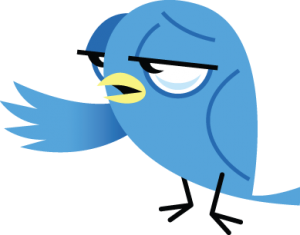 Twitter is wonderful. It allows me to talk to Sean Parker and Kevin Durant. It helps social movements organize. It’s an excellent way to keep up with breaking news. It facilitates internet-wide conversations. I’m probably not the first douchebag with a liberal arts degree to say this, but Twitter is the closest thing we have to a public sphere. Everybody gets a voice; nobodies get to talk to somebodies. The powerful still command the most attention and dominate Twitter’s search results, but more than any other platform, Twitter allows marginalized viewpoints into the fray. Moreover, I’m an active tweeter. And despite my initial misgivings, I’ve found it somewhat personally rewarding.
Twitter is wonderful. It allows me to talk to Sean Parker and Kevin Durant. It helps social movements organize. It’s an excellent way to keep up with breaking news. It facilitates internet-wide conversations. I’m probably not the first douchebag with a liberal arts degree to say this, but Twitter is the closest thing we have to a public sphere. Everybody gets a voice; nobodies get to talk to somebodies. The powerful still command the most attention and dominate Twitter’s search results, but more than any other platform, Twitter allows marginalized viewpoints into the fray. Moreover, I’m an active tweeter. And despite my initial misgivings, I’ve found it somewhat personally rewarding.
Mostly, though, Twitter is terrible.
Here’s exhibit A:
Forget everything you know about the internet for a moment, and dispassionately think about how fucking weird it is that we have collectively chosen this as a means of communicating. I mean, really think about it. Dude probably went into debt trying to get through grad school, learning to craft and defend a complex argument. And what he’s talking about here, an NBA team’s 2011 free agency prospects, is an incredibly complicated subject that would merit at least a paragraph or two.
Consider also that this guy is taking the time to publicly engage some schmo in conversation. That’s admittedly pretty amazing, and we can thank Twitter for making this sort of thing typical. But Twitter’s also to blame for how amazingly limited these conversations tend to be. There are a few ways to respond to tweets, and they’re all ugly and difficult to follow.* Meaningful dialogue is near impossible. It’s hard to believe the platform that has gone further than any other in realizing the internet’s communicative possibilities is so antithetical to dialogue.
And I’m sorry to state the obvious, but one cannot express nuanced ideas in 140 characters. When news outlets tweet, they’re often limited to the basic facts about what is happening. There’s no room to situate reports of isolated occurences in their larger context; to explain to the reader how to understand them. Conversely, when people express opinions in tweets, Twitter leaves them no room to back up their arguments with facts. Sure, tweets can link back to unbridled long-form content. But Twitter itself is increasingly a site for thoughtful discourse — and it should be, because it holds enormous potential. And as things stand, tweets are rarely persuasive. Rather, they fragment us further. Twitter ultimately allows the user to see the world through his or her own worldviews, never meaningfully challenging prejudices, never truly educating. It contributes to our media environment’s epistemic free-for-all, wherein truth is more a matter of perspective and agenda than shared facts.**
The fundamental idea of Twitter remains genius and revolutionary and worth keeping: digestible ideas shared in real time. We can fix all of its problems without sacrificing that. Keep the feed, forever putting the emphasis on staying in the moment. Keep the simple formatting. Hashtags are great. No reason to change things up too much or to impose any stylistic restrictions. Just allow a more generous character count. Let users create threads. Create a means for retweeting and adding your own comments. Allow better image and video integration.
Oh wait, I’m describing Tumblr. Let’s just all move to Tumblr.
*Here are your options for tweet-dialogue: (A) Take the aforeposted tweet’s route, clumsily tacking a response on to the end of the original message, perhaps in paranthesis or in caps to differentiate your answer. This is probably the worst; it’s unbearably ugly, and you wind up with half the characters to respond. (B) You can just tweet your response without retweeting the original message. This makes things a little difficult for third parties to follow — clicking on a tweet allows you to see the back-and-forth, but it only works some of the time, and looks terrible. (C) Probably your best option is to just retweet the original message, and then respond in a separate tweet. Still, this is also clunky, and looks terrible in the feed. Compared with the simple linear conversation of Facebook statuses, or chat programs, or real life, all of Twitter’s options suck, and discourage conversation.
**Phrasage borrowed from this essay.
This post may contain affiliate links.









